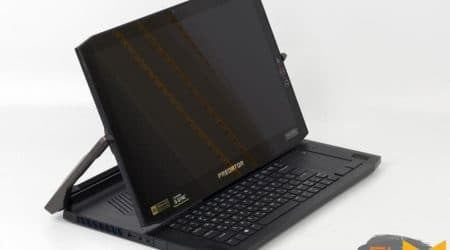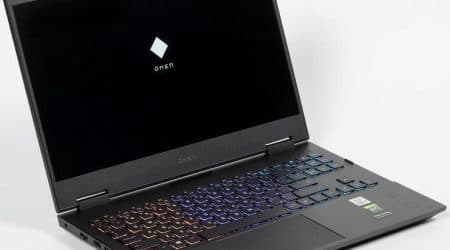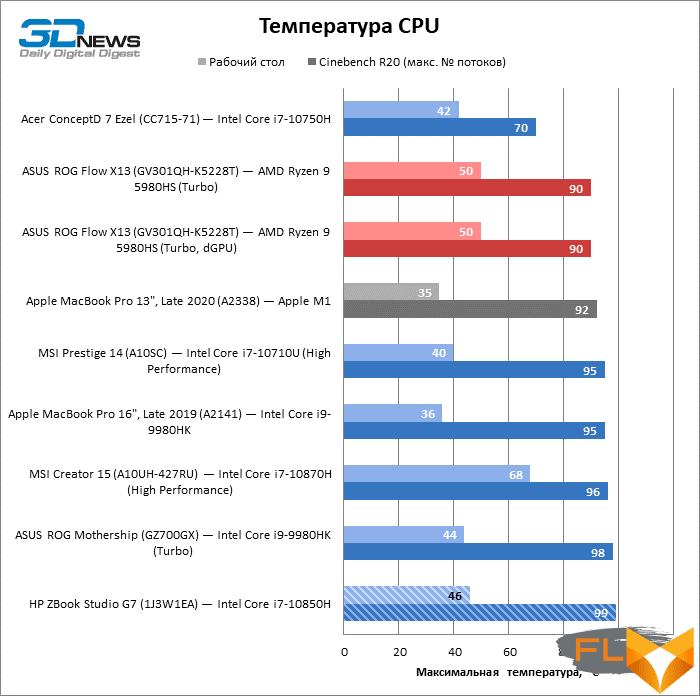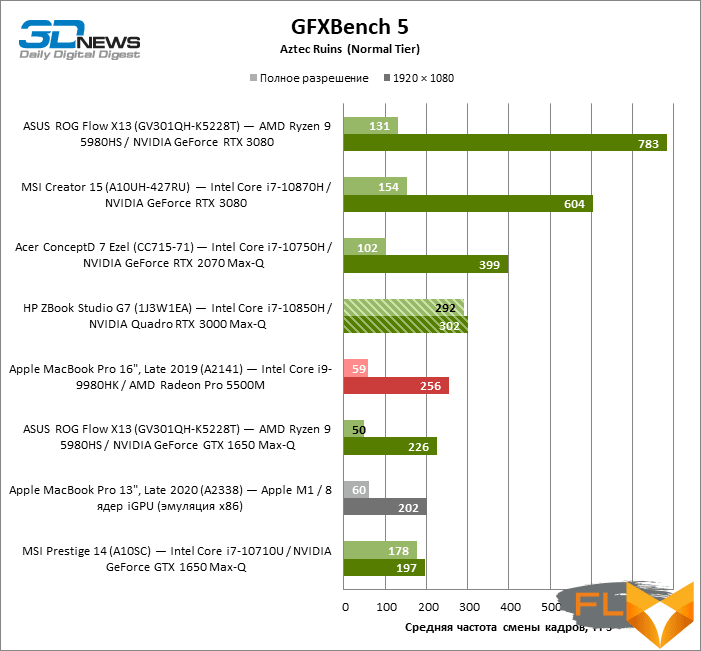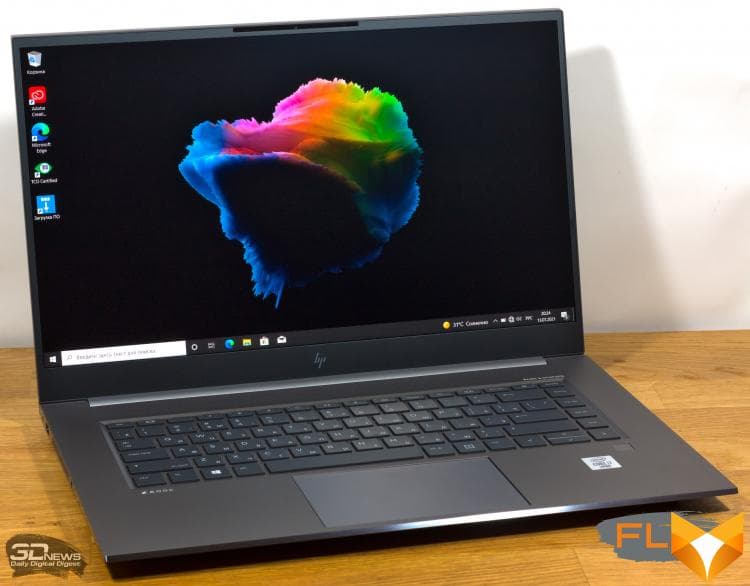


Thanks to improvements in CPU and GPU power efficiency, almost all major laptop manufacturers now offer mobile workstations in a compact form factor. However, thin laptops are still noticeably inferior to “thick” counterparts in the repertoire of components and, accordingly, performance. Exceptions are rare, and besides, attempts to cram voracious iron into a thin body most often result in strong component heating, high noise levels and mediocre battery life. Finally, according to dry technical characteristics, it is impossible to understand how high-quality the display and keyboard are installed in a particular laptop.

However, it seems that HP managed to assemble a thin work laptop from extremely powerful components and at the same time, if not completely eliminate, but at least compensate for the listed limitations of the compact form factor.
⇡#Specifications, prices
Like many other HP laptops, the ZBook Studio G7 comes in a wide variety of configurations. All of them are based on the Intel Comet Lake platform. From a formal point of view, these processors are already outdated, and in practice, the new Tiger Lake silicon demonstrates the best performance and energy efficiency. But, alas, in retail we have not yet met the next iteration of this laptop (ZBook Studio G8), equipped with advanced chips.
Be that as it may, the ZBook Studio G7 takes the best from Intel’s 10th generation platform, including older models of Core i9 processors and mobile Xeon W processors with eight x86 cores and a stock TDP of 45W. This is a very powerful filling for a thin and light 15-inch laptop, but there are simpler and, accordingly, cheaper options – for example, with six- or quad-core CPUs.
As a discrete graphics adapter, HP offers several Quadro models based on Turing GPUs, from the base Quadro T1000 to the Quadro RTX 5000, which is similar to the desktop GeForce RTX 2080 but with twice the amount of VRAM. Professional accelerators based on NVIDIA Ampere chips already exist in the mobile version, but whatever one may say, Quadro is Quadro when GPU certification for work in CAD applications and specific driver optimizations are required.
Be that as it may, in the architecture of NVIDIA’s latest and penultimate generation GPUs, there is a clear bias towards work tasks, and this is not only ray tracing using specialized logic, but also the acceleration of artificial intelligence algorithms that serve to automate routine and complex processes – such like tracking objects and faces in video editors, auto cropping, increasing video frame rate, upscaling and restoring details, removing lighting from textures, etc. All these features are supported by modern professional rendering tools (Adobe Photoshop, DaVinci Resolve) and streaming (OBS). The ZBook Studio G7 has received RTX Studio certification from NVIDIA and, of course, the Studio driver is pre-installed on the laptop – unlike a regular gaming one, it is not updated as often and is designed with stable applications running, especially in a multitasking environment.
The only weakness of the ZBook Studio G7 in the context of resource-intensive professional tasks is the amount of RAM. As the opening of the laptop will show, its components, along with a massive cooling system, are extremely densely packed in a compact case, so there was simply not enough space for removable SO-DIMM modules. The RAM chips here are soldered on the motherboard, and their total volume does not exceed 32 GB. Most work applications will be more limited to CPU and GPU speed than RAM, but this limitation of the ZBook Studio G7 should be kept in mind if you are aiming for one of the older varieties of laptops. As a drive, an NVMe SSD with a capacity ranging from 256 GB to 2 TB is used here.
The standard screen of the ZBook Stuio G7 is a Full HD IPS-matrix with sRGB color range, but if this is not enough, there is an alternative with 4K resolution and full DCI-P3 coverage, or rather two at once: IPS or OLED, and the OLED panel is also touch-sensitive. Finally, you can choose a special Full HD screen with limited viewing angles to protect sensitive information from prying eyes.
| Manufacturer | HP |
|---|---|
| Model | ZBook Studio G7 (1J3W1EA) |
| Display | 15.6”, 1920 × 1080, IPS |
| CPU | Intel Core i7-10850H (6/12 cores/threads, 2.7-5.1GHz) |
| RAM | DDR4 SDRAM, 2933 MT/s, 16 GB (dual channels) |
| GPU | NVIDIA Quadro RTX 3000 Max-Q (6GB GDDR6) |
| Drive | Samsung PM981a (PCIe 3.0 x4) 512 GB |
| External I/O connectors | 2 × Thunderbolt 3; 1 x USB 3.1 Gen 1 Type-A; 1 x Mini Display Port; 1 x TRS 3.5mm |
| Network | IEEE 802.11ax; Bluetooth 5 |
| Battery capacity, Wh | 83 |
| Weight, kg | From 1.8 |
| Overall dimensions (L × H × D), mm | 353.8 × 234.7 × 17.7 |
| Retail price | From $4200 |
In our performance tests, the ZBook Studio G7 is an average configuration across all parameters, which includes a six-core Core i7-10850H CPU, Quadro RTX 3000 graphics with 6 GB VRAM, 32 GB of system memory and a 512 GB SSD, and the screen is normal (however , tests will show that only at first glance) IPS-matrix with Full HD resolution. This is – not least because of the professional video adapter – a rather expensive computer, which cost at least $ 4,200 at the time of writing the review. Yes, and for a simplified configuration with 16 GB of RAM, 256 GB drive and Quadro T1000 require a rather large amount of $ 2,600. And at these prices, we will have to pay close attention not only to performance, but also to whether it is convenient to use a laptop in everyday work.
⇡#Look and Ergonomics
Compared to other ultrabooks, the ZBook Studio G7 is a rather hefty laptop weighing close to 2kg, but by the standards of high-performance mobile workstations, it is not only relatively light, but also thin (17.7mm when closed). And beveled edges visually lift the work surface off the table and create the illusion that the laptop is even thinner than it really is. Minimalism reigns in the design of the laptop, as befits a workstation.
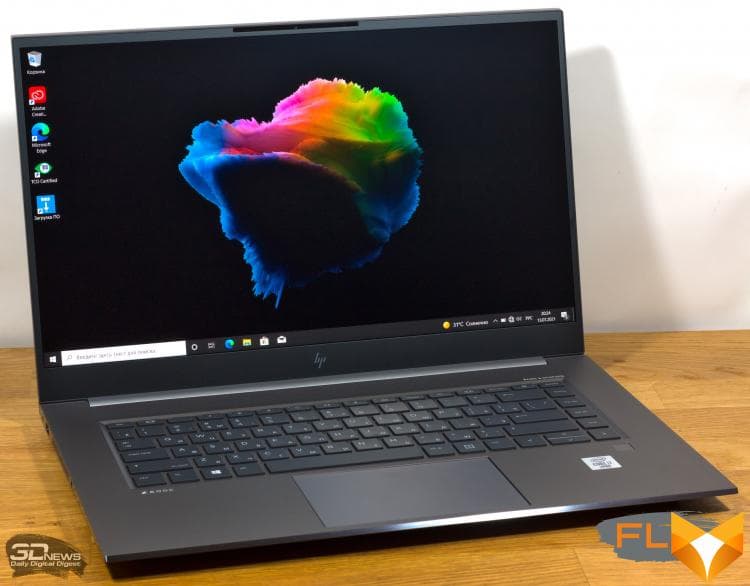
The entire body of the ZBook Studio G7, not counting the frame around the screen, is assembled from aluminum panels, and rather thick ones, which has a positive effect on the rigidity of the structure (although the dense layout of the internal elements, as well as a large cooling system, also played a role in this). You can only bend the screen cover, but this, alas, is inevitable if the screen is not laminated with glass. The touch OLED-matrix, available in other configurations of the ZBook Studio G7, is certainly devoid of such a drawback.
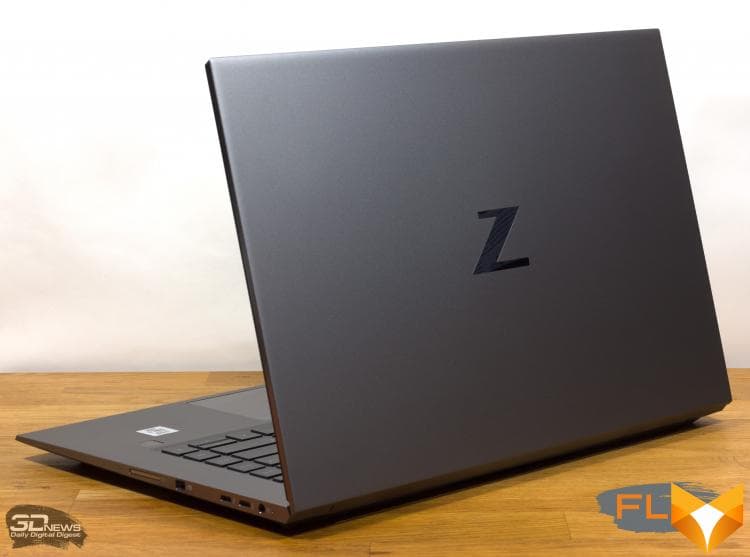
The main thing is that a solid foundation is laid under the keyboard, which does not allow the working surface to “walk” under the hands during the typing process. But that’s not all the ZBook Studio G7’s keyboard is good for. It is characterized by excellent mechanics: the moment of actuation is very clear, the covers instantly return to the neutral position. Of course, there is a backlight with several brightness levels, and another important and rare feature: channels for draining liquid from all the electronics under the keyboard in case of a flood. Perhaps the only thing you can find fault with is the relatively small size of most character keys and the narrowed “~” key. So I had to do this to squeeze in an additional column of keys PgUp, PgDn and others like them to the right of the main block. Finally, the surface of the lids is absolutely flat, although this is already a matter of taste.
Touchpad ZBook Studio G7 – to match the keyboard. The glass panel is pressed with a confident quiet click and is well fixed in the case, so that with a light touch there is no movement and extraneous sounds.
The laptop has two biometric authentication tools: a fingerprint sensor (it’s a pity that it is located separately, and not built into the power button), as well as an infrared camera.
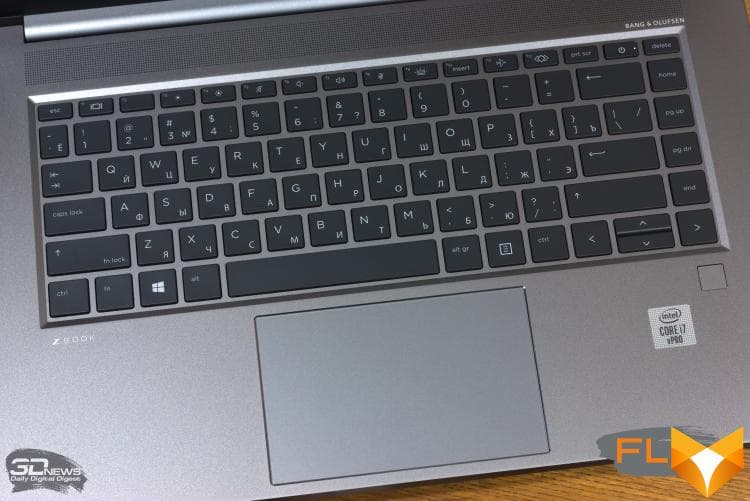
There is little room for external expansion ports on the beveled side faces of the case, especially due to the fact that the exhaust grille of the cooling system is located on the left. However, everything you need is in place: one USB Type-A 3.1 Gen 1 connector, and it is supposed to use two Thunderbolt 3 ports with a USB Type-C connector as the main interface for connecting peripherals. There is also Mini DisplayPort, which is quite rare in modern laptops, and, most importantly, a memory card reader.

The power consumption of older ZBook Studio G7 configurations does not allow using Thunderbolt 3 to charge the battery, so the laptop is powered by a 200W voltage regulator with a conventional barrel plug. However, in this case, not a faceless “brick” of a third-party manufacturer is used, but a custom – and therefore rather small – PSU under the HP brand. The cable connecting the output of the power supply to the laptop is wrapped in a fabric sheath, which is not only beautiful, but also protects the insulation from damage.

⇡#Internal design and upgrade options
As we have already seen, the ZBook Studio G7 is a very compact laptop for its configuration, which, we recall, allows you to assemble the most high-performance mobile silicon samples from Intel and NVIDIA in one case (albeit from the previous generation, but this does not change things). To provide such components with an adequate operating temperature, a serious cooling system was required, and not an ordinary one based on heat pipes, but with an evaporation chamber that covers the entire central part of the motherboard – the one where the CPU, GPU and VRM chips of both processors are located.
Two fans of the cooling system take in air through the perforation in the bottom panel of the case, and throw it sideways, through the grille on the left side, and up, between the work surface and the screen cover.
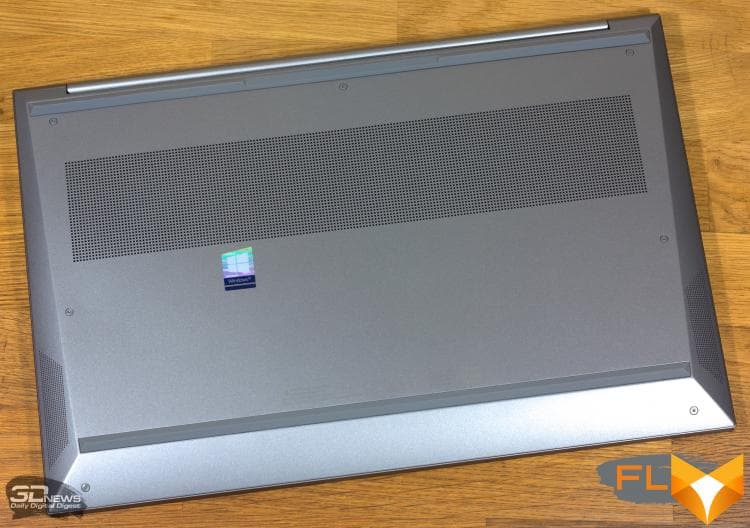
Another highlight of the HP Workstation is its solid 83 Wh battery. The only pity is that the large battery, along with the evaporation chamber, no longer left room for removable RAM modules. Fortunately, the SSD remains discrete, in the M.2 form factor, and, by the way, a separate copper heatsink is mounted on top of it. Modern SSDs aren’t at risk of overheating in a typical office or gaming laptop, but a workstation can put the SSD under prolonged stress, and enhanced cooling certainly won’t hurt.
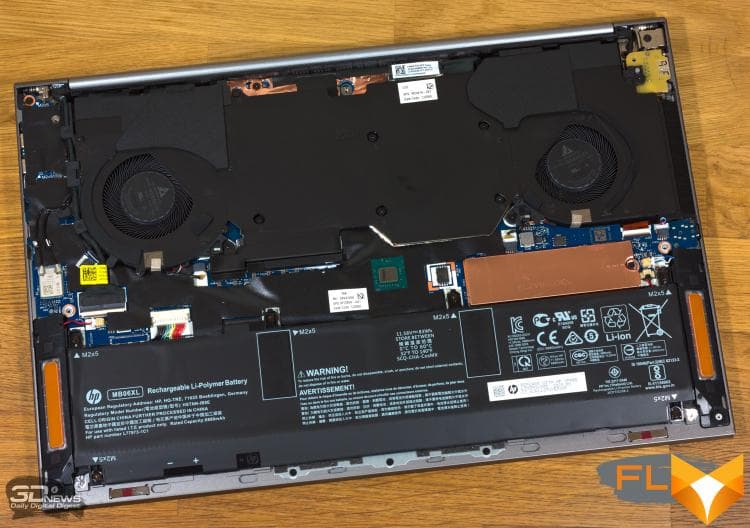
⇡#Test Methodology
| Synthetic tests | |
|---|---|
| Application | Settings |
| 3DMark Time Spy | — |
| Geekbench 4 | — |
| CINEBENCH R20 | — |
| GFXBench 5 (Aztec Ruins – Normal Tier, High Tier) | Windows: Vulkan, macOS: Metal |
| fio 3.16 | Sequential Read/Write, Random Read/Write (Unbuffered I/O) |
| Work Applications | |||||
|---|---|---|---|---|---|
| Application | Benchmark | Settings | API | ||
| Intel Graphics | AMD Graphics | NVIDIA Graphics | |||
| Adobe Photoshop CC 2019 | PugetBench for Photoshop CC 0.8 (test structure at link) | Basic Benchmark | OpenGL + OpenCL + Metal (macOS) | OpenGL + OpenCL + Metal (macOS) | OpenGL + OpenCL |
| Adobe Photoshop Lightroom Classic CC 2020 | PugetBench for Lightroom Classic 0.8 (test structure at link) | — | DirectX 12 (Windows) | DirectX 12 (Windows) | DirectX 12 |
| Adobe Premiere Pro CC 2019 | PugetBench for Premiere Pro 0.8 (test structure at link) | Standard Benchmark | OpenCL (Windows)/Metal (macOS) | OpenCL (Windows)/Metal (macOS) | CUDA |
| Fusion | |||||
| Blender 2.81a | Class Room Demo from Blender Foundation | Cycles renderer. Feature Set: Supported. Tile size: 32 × 32 (CPU) or 256 × 256 (GPU) | N/A (CPU rendering) | OpenCL (Windows)/CPU (macOS) | CUDA/OptX |
Display testing is performed using the X-Rite i1Display Pro Plus colorimeter in the DisplayCAL 3 application.
Notebook battery life is measured at a display brightness of 200 cd/m2in the following usage scenarios:
- web surfing: alternately opening and closing tabs of Computeruniverse.ru and Unsplash.com sites with an interval of 25 seconds in the Google Chrome browser (cache and cookies are disabled);
- Continuous playback of 4K HEVC (H.265) video.
⇡#Test participants
The following devices took part in testing:
| Screen | CPU | RAM | GPU | SSD | HDD | Battery | |||
|---|---|---|---|---|---|---|---|---|---|
| HP ZBook Studio G7 (1J3W1EA) | 15.6”, 1920 × 1080, IPS | Intel Core i7-10850H | 6/12 cores/threads, 2.7-5.1 GHz | DDR4 SDRAM, 2933 MT/s, 16 GB | NVIDIA Quadro RTX 3000 Max-Q | 6GB GDDR6 | Samsung PM981a (PCIe 3.0 x4) 512 GB | No | 83 Wh |
| Acer ConceptD 7 Ezel (CC715-71) | 15.6”, 3840 × 2160, IPS | Intel Core i7-10750H | 6/12 cores/threads, 2.6-5.0 GHz | DDR4 SDRAM, 2666 MT/s, 16 GB | NVIDIA GeForce RTX 2070 Max-Q | 8GB GDDR6 | RAID 0: 2 × Samsung PM981a (PCIe 3.0 x4) 512 GB | No | 84 Wh |
| Apple MacBook Pro 13″, Late 2020 (A2338) | 13.3”, 2560 × 1600, IPS | Apple M1 | 4+4 cores/threads, ≤3.2 GHz | LPDDR4X SDRAM, 4266 MT/s, 16 GB | 8 iGPU cores | System RAM | Apple AP2048Q (Apple Fabric) 2048 GB | No | 58.2 Wh |
| Apple MacBook Pro 16″, Late 2019 (A2141) | 16”, 3072 × 1920, IPS | Intel Core i9-9980HK | 8/16 cores/threads, 2.4-5.0 GHz | DDR4 SDRAM, 2666 MT/s, 16 GB | AMD Radeon Pro 5500M | 4GB GDDR6 | Apple AP1024N (PCIe 3.0 x4) 1024 GB | No | 100 Wh |
| ASUS ROG Flow X13 (GV301QH-K5228T) | 13.4”, 3840 × 2400, IPS | AMD Ryzen 9 5980HS | 8/16 cores/threads, 3.1-4.8 GHz | LPDDR4X SDRAM, 4266 MT/s, 32 GB | NVIDIA GeForce GTX 1650 Max-Q | 4GB GDDR6 | WD PC SN530 (PCIe 3.0 x4) 1024 GB | No | 62 Wh |
| ASUS ROG Flow X13 (GV301QH-K5228T) | 13.4”, 3840 × 2400, IPS | AMD Ryzen 9 5980HS | 8/16 cores/threads, 3.1-4.8 GHz | LPDDR4X SDRAM, 4266 MT/s, 32 GB | NVIDIA GeForce RTX 3080 | 16GB GDDR6 | WD PC SN530 (PCIe 3.0 x4) 1024 GB | No | 62 Wh |
| ASUS ROG Mothership (GZ700GX) | 17.3”, 3840 × 2160, IPS | Intel Core i9-9980HK | 8/16 cores/threads, 2.4-5.0 GHz | DDR4 SDRAM, 2666 MT/s, 64 GB | NVIDIA GeForce RTX 2080 | 8GB GDDR6 | RAID 0: 2 × Intel SSD 760p (PCIe 3.0 x4) 512GB + Samsung PM981 (PCIe 3.0 x4) 512GB | No | 90 Wh |
| MSI Creator 15 (A10UH-427RU) | 15,6”, 3840 × 2160, IPS | Intel Core i7-10870H | 8/16 cores/threads, 2.2-5.0 GHz | DDR4 SDRAM, 3200 MT/s, 32 GB | NVIDIA GeForce RTX 3080 | 16GB GDDR6 | Samsung PM981 (PCIe 3.0 x4) 2048 GB | No | 99 Wh |
| MSI Prestige 14 (A10SC) | 14”, 1920 × 1080, IPS | Intel Core i7-10710U | 6/12 cores/threads, 1.1-4.7 GHz | LPDDR3 SDRAM, 2133 MT/s, 16 GB | NVIDIA GeForce GTX 1650 Max-Q | 4GB GDDR6 | Samsung PM981 (PCIe 3.0 x4) 1024 GB | No | 52 Wh |
⇡#Screen Quality
The base version of the HP ZBook Studio G7’s on-screen matrix isn’t as high resolution as the alternatives available in higher-end laptop configurations, but otherwise it’s a great display that’s good for color work even without custom calibration. Let’s start with a huge margin of brightness of 478 cd/m2 and a contrast ratio of 1571:1. The range of shades of the matrix almost entirely covers the sRGB space.
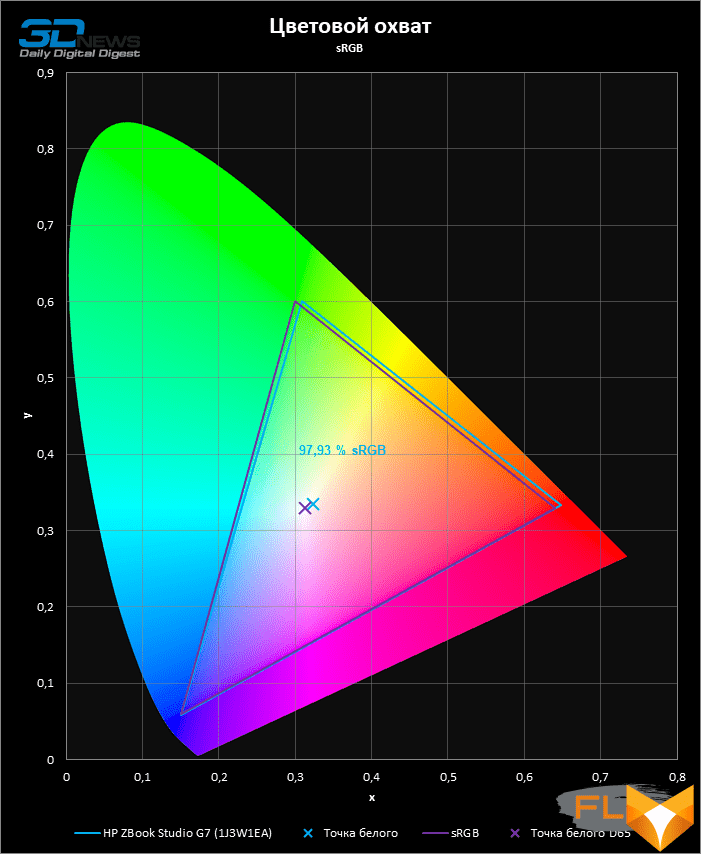
But the color temperature is underestimated relative to the standard 6500 K.

And the gamma correction curve behaves strangely in bright colors, which leads to a visual drop in contrast.
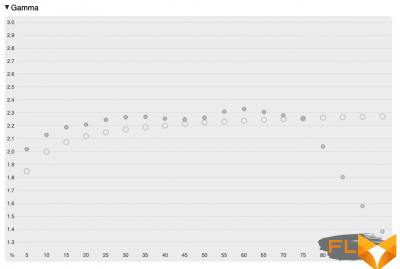 |
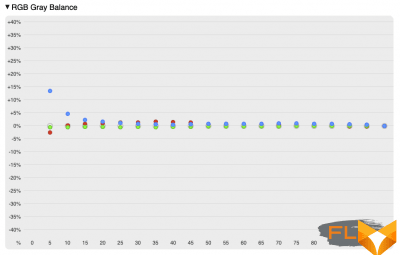 |
But, and most importantly, the screen of the HP ZBook Studio G7 boasts excellent gray balance and, as a result, very high color accuracy according to Delta E.
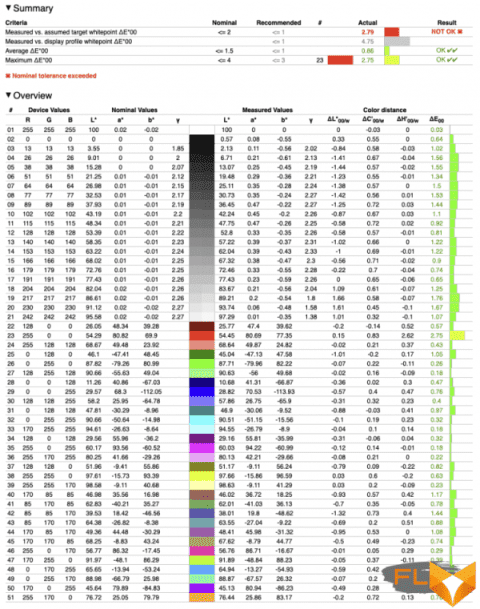
⇡#Clock speeds, temperature and noise levels
All Comet Lake-based H-series chips have a sustained power consumption of 45W. But we were quite surprised when it turned out that the CPU of the HP ZBook Studio G7 was brought up to the maximum power of 65 W allowed by the specifications, and this power is maintained during long-term multi-threaded work, and the clock frequency of the cores is kept at 3.8 GHz . It turns out that something, and the performance of the CPU in this case is definitely not affected by the compact form factor.
The Quadro RTX 3000 video adapter also demonstrated high clock frequencies (adjusted for the Max-Q thermal package): an average of 1.276 GHz with a power consumption of 60 watts.
With simultaneous load on the central and graphics processor, as usual, the GPU takes the lion’s share of the power, and its frequency has not decreased at all. However, the CPU also dipped to just 35W, which exactly matches the minimum TDP configuration of Comet Lake chips. Of course, the clock speeds of the x86 cores had to be reduced to 2.177 GHz, but other compact laptops in such conditions do not allow counting on such a result.
| Clock speeds under load | ||||||||
|---|---|---|---|---|---|---|---|---|
| Cinebench R20 (Max thread no.) | LuxMark 3.1 | Cinebench R20 (max thread no.) + LuxMark 3.1 | ||||||
| CPU clock speed, MHz | GPU clock speed, MHz | CPU clock speed, MHz | GPU clock speed, MHz | |||||
| Medium | Max | Medium | Max | Medium | Max | Medium | Max | |
| HP ZBook Studio G7 (1J3W1EA) – Intel Core i7-10850H / NVIDIA Quadro RTX 3000 Max-Q | 3800 | 3990 | 1276 | 1320 | 2177 | 2394 | 1287 | 1350 |
| CPU and GPU power | ||||||||
|---|---|---|---|---|---|---|---|---|
| Cinebench R20 (Max thread no.) | LuxMark 3.1 | Cinebench R20 (max thread no.) + LuxMark 3.1 | ||||||
| CPU Wattage | GPU power consumption (SoC as a whole, if integrated), W | CPU Wattage | GPU power consumption (if discrete), W | |||||
| Medium | Max | Medium | Max | Medium | Max | Medium | Max | |
| HP ZBook Studio G7 (1J3W1EA) – Intel Core i7-10850H / NVIDIA Quadro RTX 3000 Max-Q | 65 | 69 | 60 | 60 | 35 | 35 | 63 | 63 |
Note The measurement is performed after the device has warmed up and all parameters have stabilized.
Of course, the huge reserve of power allocated to the main components by the standards of ultrabooks causes serious heat dissipation. With NVIDIA GPUs, the temperature is always limited to a certain limit – in this case, it does not exceed 77 ° C. But the CPU warms up to 99 – despite the fact that temperature throttling takes effect at around 100 ° C.
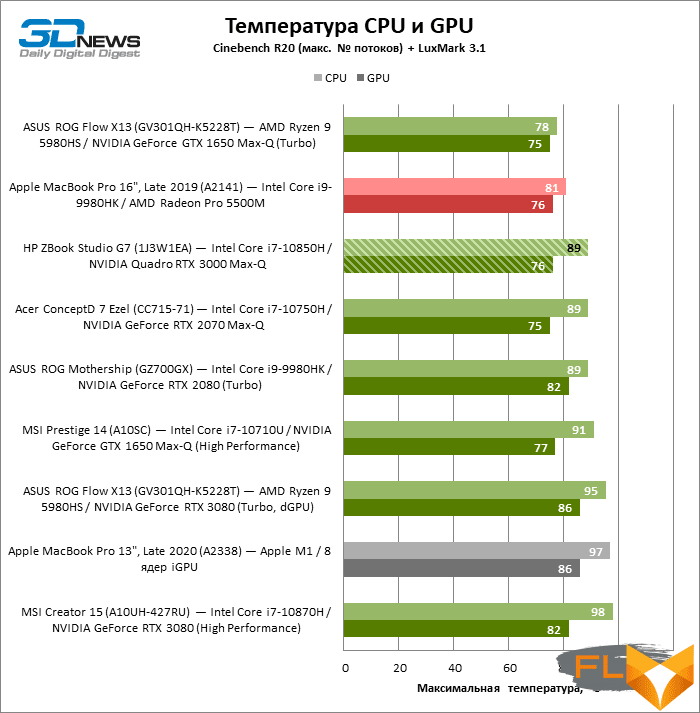
Yes, and the ZBook Studio G7 is pretty noisy – both at maximum load on the CPU or GPU, and with a combined one. There aren’t many laptops in our benchmark database with this combination of components and form factor. However, all machines with similar configurations have the same high noise level, while each of them is either thicker than the ZBook Studio G7 or inferior to the HP product in the combined performance of the CPU and GPU.
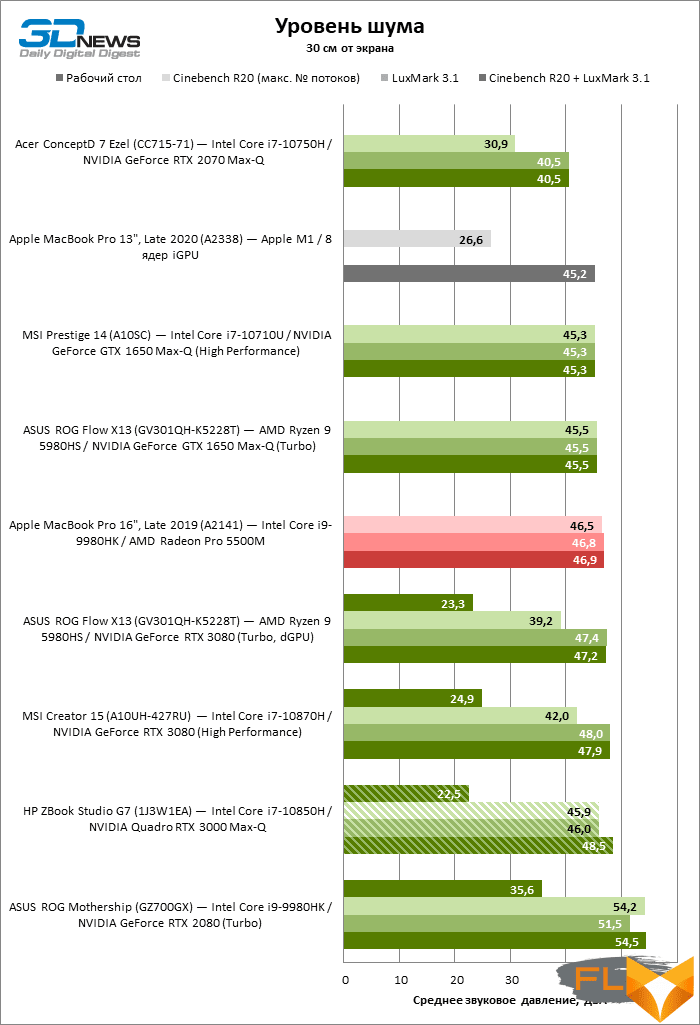
⇡#Synthetic performance tests
Most of the laptops we’ve chosen to compare with the ZBook Studio G7 also feature a six- or eight-core 10th Gen Intel processor with an H in the name. As a result, it’s not at all surprising that the HP notebook placed among these machines in our multi-threaded CPU performance tests. Fundamentally higher performance is provided only by eight-core Intel chips with a large power reserve and, of course, Ryzen 5000 series processors.
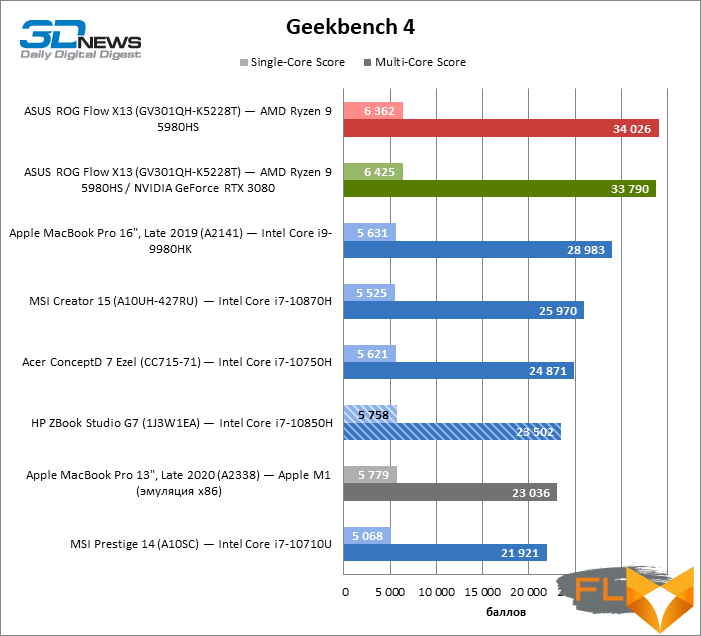
As for graphics, among desktop video cards, the analogue of the mobile version of the Quadro RTX 3000 is the GeForce RTX 2060, and here it is also limited by the Max-Q thermal package. As a result, the ZBook Studio G7 cannot be compared to workstations that are equipped with GeForce RTX 2080 or RTX 3080-class accelerators. However, the performance of the Quadro RTX 3000 looks good against the backdrop of the achievements of the GeForce RTX 2070, also in Max-Q, and, of course, far exceeds the capabilities of any GeForce GTX 1650 Max-Q, not to mention the hardware-accelerated ray tracing feature.
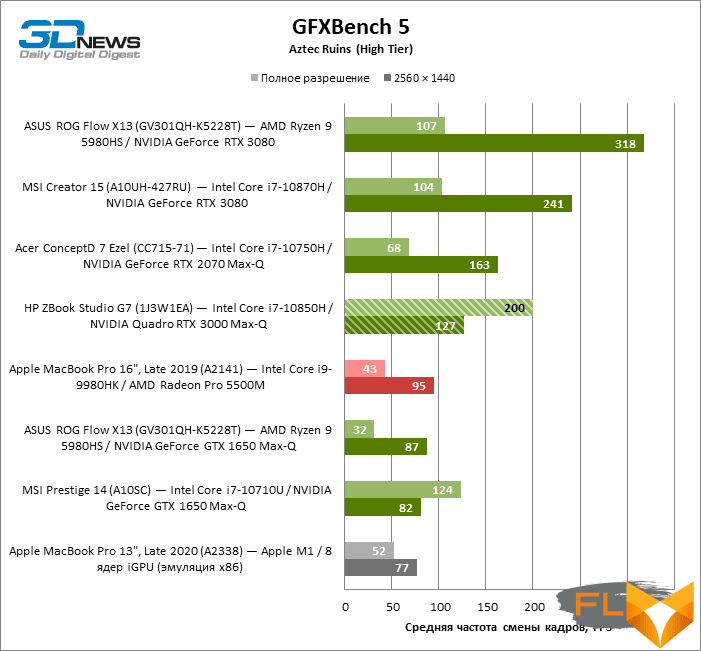
⇡#Performance in production applications
The ZBook Studio G7 performed well on the CPU rendering task of Blender, where it was only slightly behind the machine with its sister octa-core CPU. Although the more powerful eight-core Intel and, of course, the Ryzen 5000 series are unconditionally in the lead here.
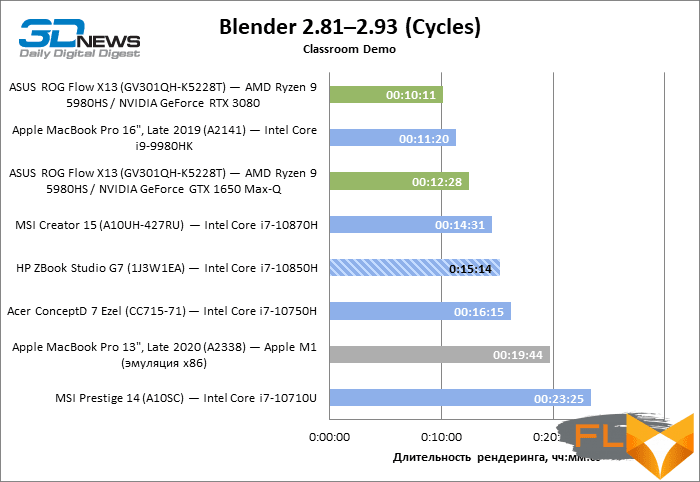
Despite the noticeable difference in technical specifications, the Quadro RTX 3000 discrete graphics are not that far behind the mobile GeForce RTX 2070 in a similar test and even outperformed the latter when hardware ray tracing was involved. In more complex projects, the Quadro RTX 3000 is limited not only in terms of GPU speed, but also because of the modest amount of VRAM, and still it is an incomparably better solution for workloads than mobile accelerators of the GeForce GTX 1650 class.
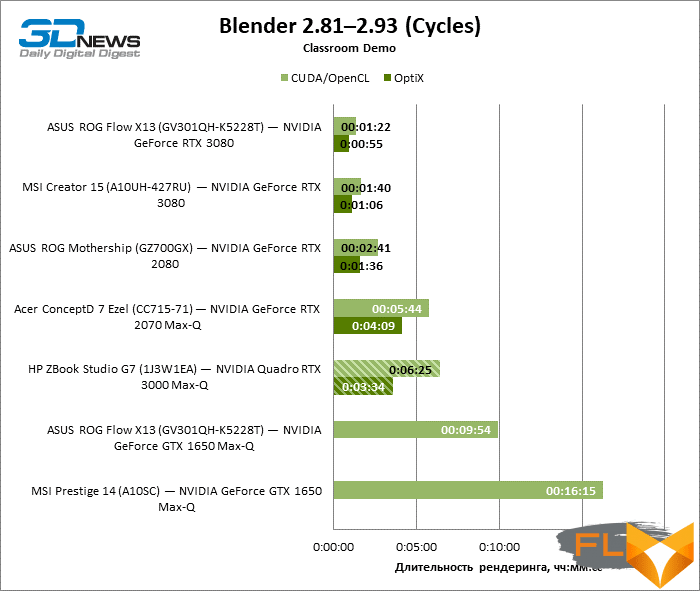
The ZBook Studio G7 does not break records in the Lightroom benchmark, but most of the test participants, with the exception of the most powerful laptops, from a practical point of view, have equivalent performance in this group of tasks.

Note Scores are calculated as a percentage of Intel Reference Workstation performance Core i9-9900K, NVIDIA GeForce RTX 2080, 64GB RAM.
The same conclusions hold true for the results of the Photoshop test.
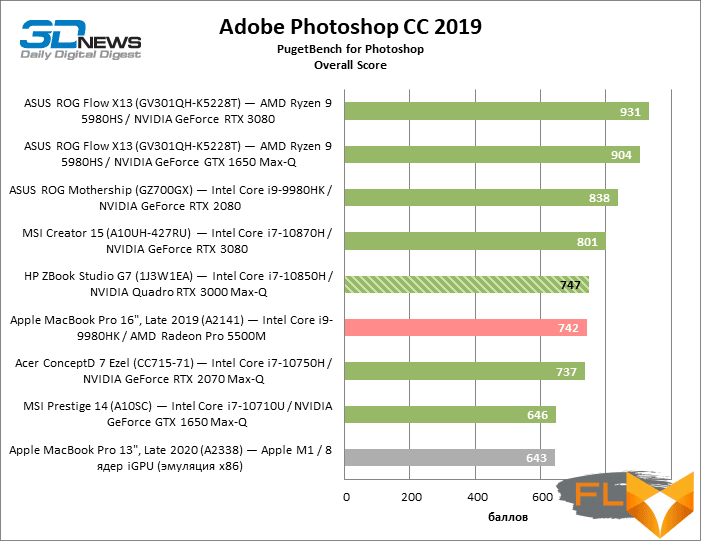
Note Scores are calculated as a percentage of Intel Reference Workstation performance Core i9-9900K, NVIDIA GeForce RTX 2080 and 64GB RAM x 10.

Note Scores are calculated as a percentage of Intel Reference Workstation performance Core i9-9900K, NVIDIA GeForce RTX 2080, 64GB RAM.
The Premiere Pro test suite summary gave the ZBook Studio G7 a good score for playback speed, but it performed mediocre when exporting a project.
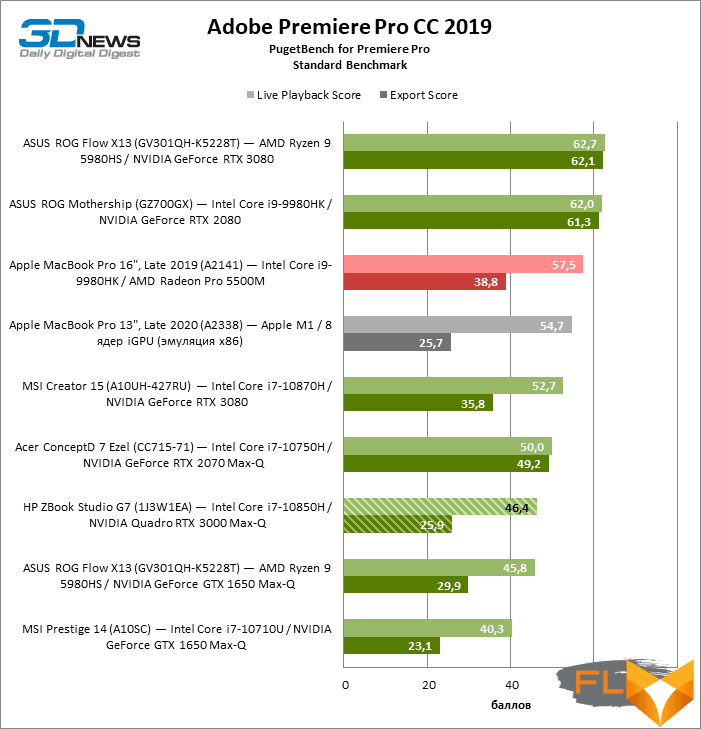
Note Scores are calculated as a percentage of the frame rate of the source or target format (for example, playing a video at full frame rate is worth 100 points). Unlike playback, when rendering video, the frame rate can exceed the target, which means that the score will be higher than 100.
As far as live playback is concerned, the ZBook Studio G7 handles complex GPU-based effects better and delivers fairly high framerates using a proxy, but you can’t say that for effects that require a powerful CPU: whatever one may say, this configuration is not a couple more x86 cores would have been in the way.
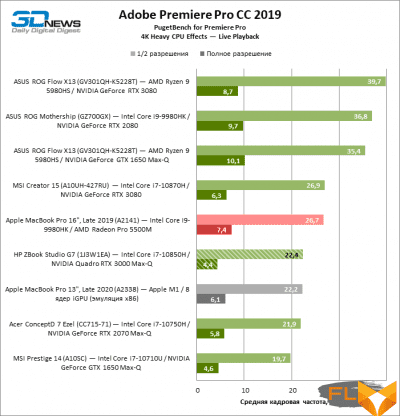 |
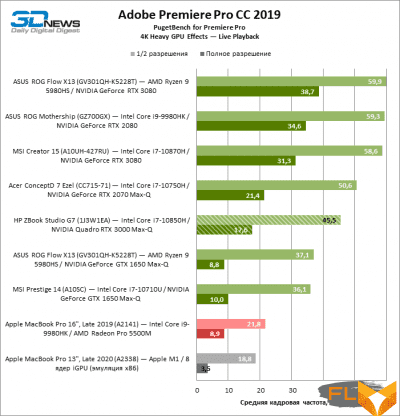 |
A similar situation occurred in the export tasks: here the competing devices lined up in order of CPU and GPU performance. A more powerful CPU and even more so a video adapter give other laptops drastically reduced rendering times compared to the results of the ZBook Studio G7. Be that as it may, an HP product, even in a far from maximum configuration, is quite worthy of the title of a mobile workstation – unlike machines with weaker discrete graphics, because a strong GPU in Premiere Pro is indispensable.
 |
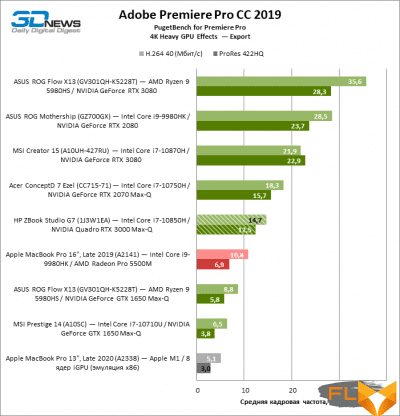 |
A fairly powerful Quadro RTX 3000 video adapter also helped the HP laptop to take its rightful place among the test participants in the DaVinci Resolve benchmark.
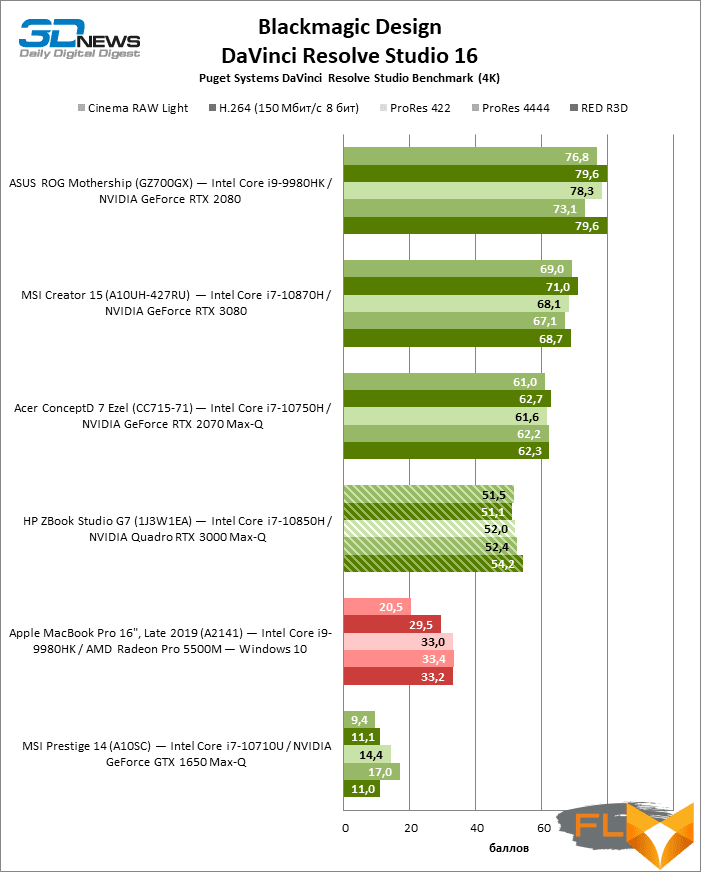
Note Scores are calculated as a percentage of the performance of a reference workstation with Intel Core i9-9900K and NVIDIA TITAN RTX.
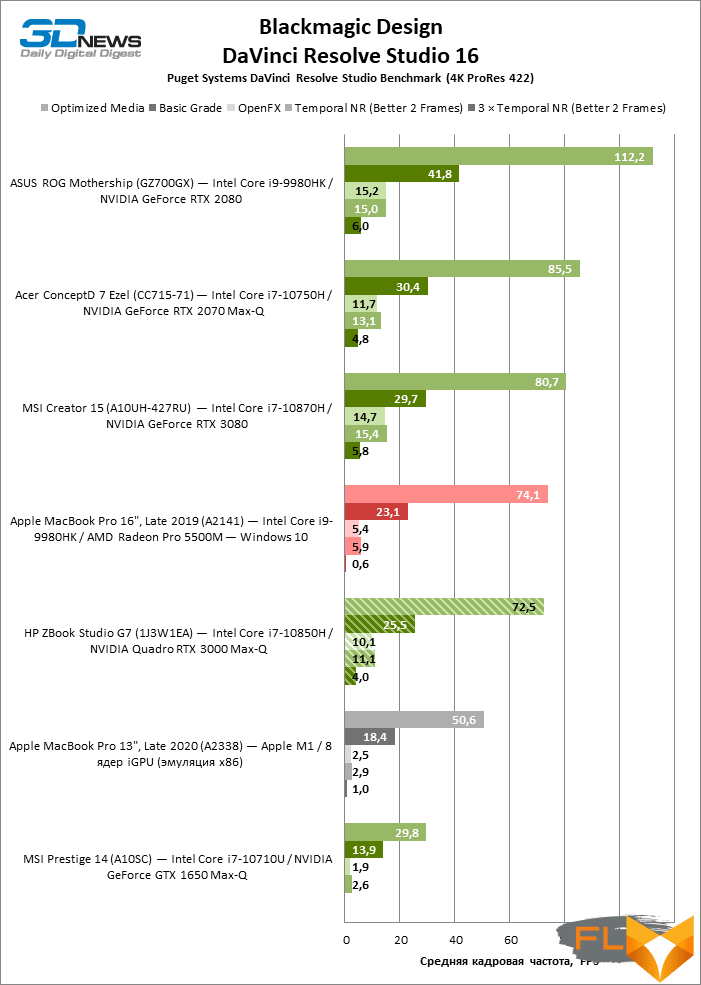
The effects of Fusion, on the other hand, are more dependent on the speed of the CPU, so the gap between the ZBook Studio G7 and most of its superior rivals was smaller – except for machines with the most headroom dedicated to the CPU.
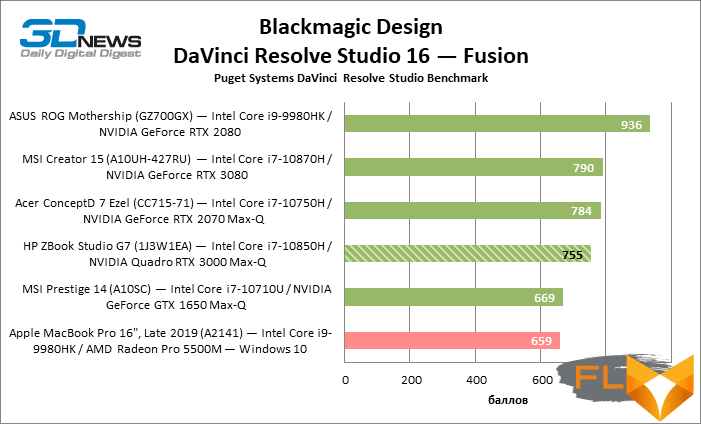
Note Scores are calculated as a percentage of the performance of a reference workstation based on Intel Core i9-9900K and NVIDIA TITAN RTX multiplied by 10.
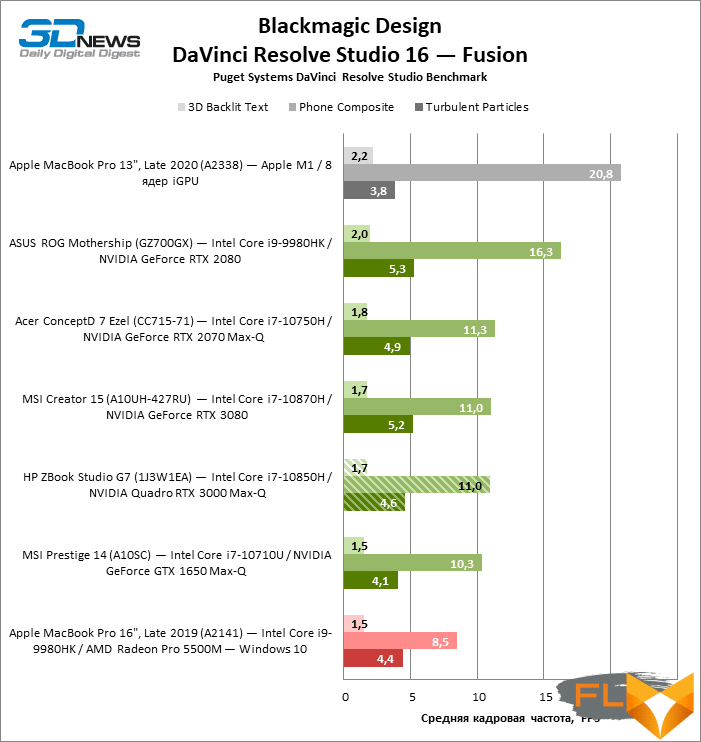
⇡#SSD Performance
The HP ZBook Studio G7 test unit has a 512GB Samsung PM981a drive that scores well in all aspects of performance except random write. But there is one caveat: linear writing at the maximum speed possible with four commands in a queue or more, this SSD supports only for a few seconds, and then it drops to a level just above 1 GB / s.
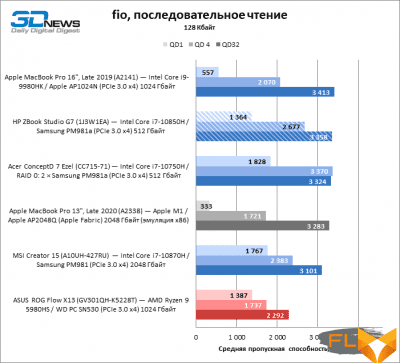 |
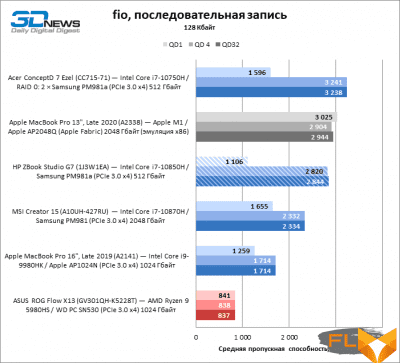 |
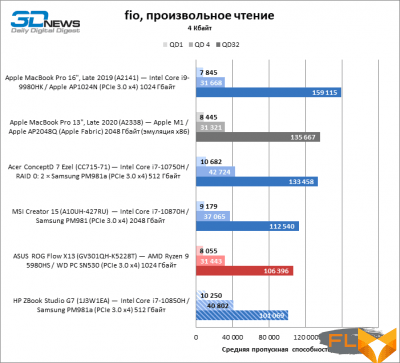 |
 |
⇡# Battery Life
Thanks to the capacious battery, the HP ZBook Studio G7 is able to work for a very long time on a single charge. Of course, you should not load a laptop with video editing and 3D-rendering off the wall, but in light tasks – such as surfing the web or watching videos – you can safely count on the fact that it will last at least 9 hours without recharging, or rather 9 hours 4 minutes of web surfing and 9 hours 35 minutes of video (with screen brightness reduced to 200 cd/m2).
⇡#Conclusions
The HP ZBook Studio G7 belongs to the recently born category of laptops at the junction between an ultrabook and a portable workstation. But the HP product differs from numerous analogues in that its configuration is leaning towards the workstation: all ZBook Studio G7 models are equipped with NVIDIA Quadro video adapters (including the top-end mobile version of the Quadro RTX 5000) and there is an Xeon option among the available CPUs. The components of the laptop are cooled by a highly efficient vapor chamber, thanks to which they maintain unexpectedly high clock speeds for such a modest size.
It can be argued that there are plenty of high-performance laptops now, and the ZBook Studio G7, whatever one may say, is based on the silicon of the previous generation. In addition, the choice in favor of discrete Quadro graphics over conventional GeForce clearly reflected in the price. Indeed, even in the far from the maximum configuration that participated in our tests, the ZBook Studio G7 costs almost $4,200.
However, neither money, nor even the hardware configuration, guarantees quality in such important aspects as the screen, controls and the overall design of the laptop. And with this, the ZBook Studio G7 is in perfect order. It turned out that even the base screen matrix is one of the best Full HD panels we have ever seen in a mobile computer (and there are 4K options based on IPS or OLED). The same, of course, can be said about the mechanics of the keys. Finally, one battery charge is enough for more than 9 hours of operation. This means that among all the modifications of the ZBook Studio G7, not only older, but also intermediate and even younger models are worthy of attention – already as an excellent (although still very expensive) ultrabook with the makings of a workstation.
Perhaps the only thing that the ZBook Studio G7 lacks is the ability to expand RAM, as well as additional ports for connecting peripherals, but these are already the costs of a compact form factor.
